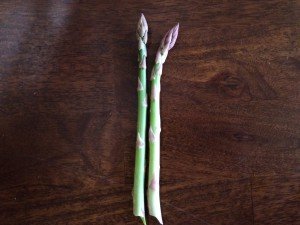First* strawberry of spring!*technically the third one to ripen, but the first one that I beat the birds to. The strawberries are now covered enough to keep birds and squirrels out but let the pollinators in.
Read MoreA Berry Short Haircut
Last fall I had a niggle as I watched the lush, green growth of the strawberries yellow in some places and brown in other. I made a cursory search for winterizing strawberries and fall strawberry preparation and did not find what I was looking for, so called it good and lived in ignorant bliss all winter.This year, as spring sprung and my strawberry plants reached an almost concerning level of denseness while thickly mulched with some of last years dying and crumbling growth, I searched again and still came up with nothing and went back to my bliss and the rest of my to-do list.Then a few weeks ago I saw a video from Curtis Stone visiting a farmer in New Zealand, who, by the way, fetched 661 lbs. of strawberries off of his 600 first year plants discussing between 3:55 - 6:05, cutting down the current year's growth to force the plant into new, disease and fungus free growth for next year.My June Bearing Strawberries are already thickly in bloom, covered in green strawberries and tonight I saw the first blush of pink. Since I cannot do anything else until the end of this year's growing season, I went back to my research and found that a slightly different search term (cutting back strawberries) yielded the result I was seeking.This is one of those bad news/good news things.Bad news: The only thing I can really do between now and the end of season when I can cut back the green growth and make clean beds for next year, pulling out the older plants, making room for newer growth, is hand cleaning some of the decaying leaves, using them for mulch on very different plants so as not to transmit any fungus or disease between cultivars.Good news: In this case, that persistent niggle is my good news. I am far from an expert and I don't hold the title Master Gardener, but I am beginning to have a real intuition, a sense of what might need to be researched and considered for my various plants. I do consider myself a pretty good researcher and on this one I missed my target more than once, but I am feeling good that I have an idea of which questions need to be asked and will listen even more closely going forward. Answers, clearly, may vary!#Kaizen
Read MoreFinally Spring - Garden Update
The average last frost date for this area has come and gone and the lowest nighttime temp forecast through the end of the month is 41. I think spring is finally here to stay!The French Breakfast Radishes are speeding toward their 25 days to maturity and the Lollo De Vino Lettuce is by far, the prettiest lettuce I have ever grown.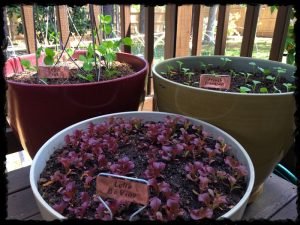 The strawberries are already thickly covered in blooms and green berries.
The strawberries are already thickly covered in blooms and green berries.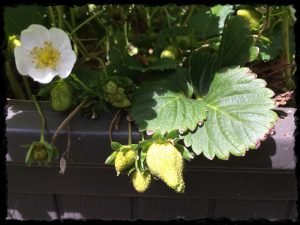 And speaking of "thick", the June-bearing variety I have put out an outrageous number of runners. I tried to stay on top of it last year, giving away dozens of rooted starts and adding many more to the compost bin, but they still managed to do a little guerrilla gardening of their own, sneaking out some late season runners to plant offspring around the designated 4'x8' beds.
And speaking of "thick", the June-bearing variety I have put out an outrageous number of runners. I tried to stay on top of it last year, giving away dozens of rooted starts and adding many more to the compost bin, but they still managed to do a little guerrilla gardening of their own, sneaking out some late season runners to plant offspring around the designated 4'x8' beds.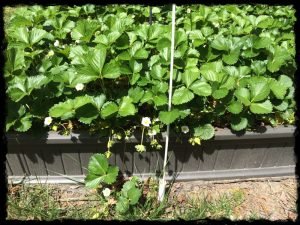 The blueberry bushes are also covered in unripe berries and continuing to bloom. This is their second summer in place and I am hoping the January pruning results in even larger, more plentiful berries than last year.
The blueberry bushes are also covered in unripe berries and continuing to bloom. This is their second summer in place and I am hoping the January pruning results in even larger, more plentiful berries than last year.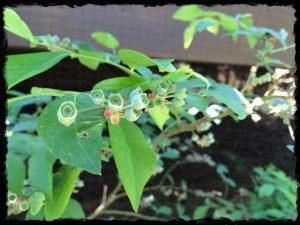 I am growing 2 varieties of Sugar Snap Peas this year, finishing out the last of my Sugar Anns and also growing a variety call simply Sugar Snap.
I am growing 2 varieties of Sugar Snap Peas this year, finishing out the last of my Sugar Anns and also growing a variety call simply Sugar Snap.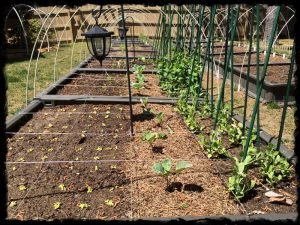 The collards and lettuces in the garden are off to a slow start which I attribute to the mostly cooler weather we have had this spring. With daytime highs starting to reach into the high 70s and low to mid 80s, I think their growth rate will pick up quickly in the next few weeks.And last, but never least, the tomatoes.
The collards and lettuces in the garden are off to a slow start which I attribute to the mostly cooler weather we have had this spring. With daytime highs starting to reach into the high 70s and low to mid 80s, I think their growth rate will pick up quickly in the next few weeks.And last, but never least, the tomatoes.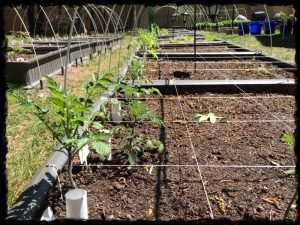 Of the 38 tomatoes that were emancipated at the end of March, I have 37 that are doing very well. The septoria leaf spot has dramatically slowed in it's progression since they were moved outside and the one Rebekah Allen tomato plant that was lost to a nighttime nibbler, has been reseeded indoors and will be replaced outdoors in a month or so.This weekend I will be sowing more herbs in the front and reseeding some of the spinach that has had less than stellar germination rates this year."In the spring, at the end of the day, you should smell like dirt." ~ Margaret Atwood
Of the 38 tomatoes that were emancipated at the end of March, I have 37 that are doing very well. The septoria leaf spot has dramatically slowed in it's progression since they were moved outside and the one Rebekah Allen tomato plant that was lost to a nighttime nibbler, has been reseeded indoors and will be replaced outdoors in a month or so.This weekend I will be sowing more herbs in the front and reseeding some of the spinach that has had less than stellar germination rates this year."In the spring, at the end of the day, you should smell like dirt." ~ Margaret Atwood
Avant Garden
The single, yellowed leaf I found on one of my paste tomatoes at the end of February was actually the opening shot of a fungal tug-of-war that will likely continue for the whole of 2016's growing season. The Septoria Leaf Spot fungus which can cause damage to tomatoes by defoliation leading to sunburned fruit has been mostly contained by removal of affected leaves and regular use of a homemade organic fungicide (1 gallon of water, 2 TBS vegetable oil and 2 TBS baking soda) but the close proximity of the plants to each other while they are stuck in my indoor grow room was almost certainly encouraging the spread of the fungus.With about a week to go before the last frost date for my area, I have been obsessively checking the 15 day weather forecast for the past few days to determine whether I could risk putting the tomatoes out a little early to give them some much needed space, fresh breezes and sanitizing sunshine to inhibit the fungus from spreading. Today I rolled the dice and moved them to the great outdoors!The PVC tubes that my bamboo tomato supports fit into are already in place so the plant roots will not be disturbed later in the season when they are necessary and the tomatoes have been hardened off.Last year I had a handful of tomatoes that had blossom end rot so I saved eggshells all winter and crushed them into a powder to provide more calcium to the plants. Tomatoes are a vine plant that will root along their stem, so mine were laid down in the channel I dug rather than placed upright. Eggshells were spread beneath and on top of the root area.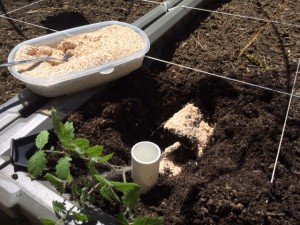 The stem is gently bent at a 90 degree angle several inches up from the top of the soil line from the starter cup. Roots will develop along this stem and according to Charles H. Wilbur, more roots will result in more tomatoes.
The stem is gently bent at a 90 degree angle several inches up from the top of the soil line from the starter cup. Roots will develop along this stem and according to Charles H. Wilbur, more roots will result in more tomatoes.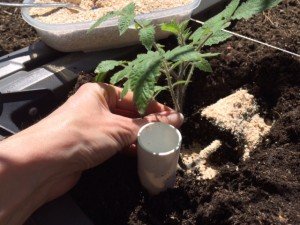 Soil is patted down over the tomato root and around the bent stem and any leaves touching or near ground level are removed to avoid splash up from the soil leading to new and exciting fungal infections.
Soil is patted down over the tomato root and around the bent stem and any leaves touching or near ground level are removed to avoid splash up from the soil leading to new and exciting fungal infections.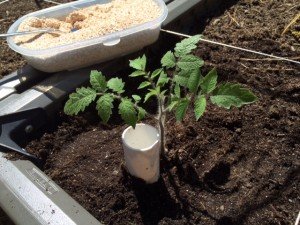 Repeat 37 more times then relax and start compiling fabulous tomato recipes like this one while you wait for the fruits of summer to appear!
Repeat 37 more times then relax and start compiling fabulous tomato recipes like this one while you wait for the fruits of summer to appear!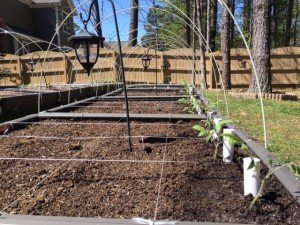
Making Lemonade
Unless I take the time to carefully pluck them out, one by one, before taking a garden pic, you have probably noticed the indecent number of pine needles lurking in the background of EVERY PHOTO I TAKE!Once upon a time I had big dreams of chicken wire leaf bins in my backyard to effortlessly convert the sweet gumball and maple leaves raked up each fall into garden gold over the course of a year. In these fantasies I would empty the bins the following fall and add the compost to my garden before starting the cycle over again.Instead, the home I purchased has pine trees. Loblolly Pine trees (Pinus taeda) to be exact and the leaves they shed do not turn into lovely compost over the course of a year but instead, remain defiantly pine needle-like for much, much longer.After a bit of debate and confirming that pine needles making soil acidic is actually an old wives tale, I decided to compost them anyway (note: this was my idea, not the pine needles').Then, magically, after two years of composting, I have...pine needles!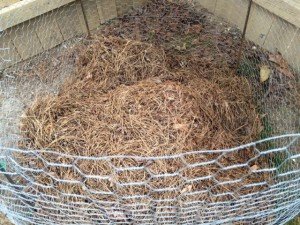 Pine needles don't turn into compost very quickly, but one of my goals this year is to mulch and I have been casting around for a sustainable, organic mulch that would work well in my garden beds. After two years of composting, I did get somewhat broken down needles that would work very well as a mulch.
Pine needles don't turn into compost very quickly, but one of my goals this year is to mulch and I have been casting around for a sustainable, organic mulch that would work well in my garden beds. After two years of composting, I did get somewhat broken down needles that would work very well as a mulch.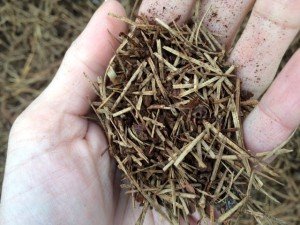 I started mulching around my transplanted collards while I wait for my direct sown spinach and sugar snap peas to fully sprout and I have to admit the result is quite nice.
I started mulching around my transplanted collards while I wait for my direct sown spinach and sugar snap peas to fully sprout and I have to admit the result is quite nice.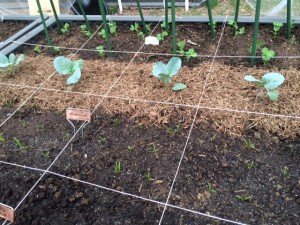 Because I have been turning the needles in their bin throughout the year, I know they hold moisture and attract earthworms so should work well as a mulch.
Because I have been turning the needles in their bin throughout the year, I know they hold moisture and attract earthworms so should work well as a mulch.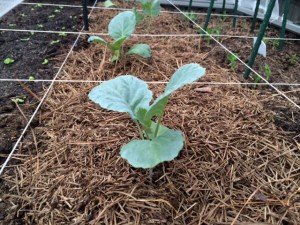 Okay, that was a completely gratuitous pic just because they looked so pretty.So now, I have made lemonade from my lemons and looking over my garden plan now I find myself in the position I could not have conceived of a year ago, I am not sure I have enough pine needles!
Okay, that was a completely gratuitous pic just because they looked so pretty.So now, I have made lemonade from my lemons and looking over my garden plan now I find myself in the position I could not have conceived of a year ago, I am not sure I have enough pine needles!
Paradigm Shift
I sometimes forget the prevailing notions people have related to growing food. The most common mental images seem to center around long hours of back breaking labor spent tilling, planting, hoeing and weeding.I am quickly reminded of the current thinking when I breezily say things like, "I planted 288 spinach plants today and need to do the same for lettuce tomorrow." and the person I am speaking with gapes in horror at the perceived amount of time and effort that goes into it. But the chasm between what they are thinking and what I actually did is as big as the Grand Canyon. We are operating under two VERY different paradigms when it comes to growing food...Depending on the agricultural model used, growing food can be relatively low-labor and the little time and money spent in the garden is subtracted directly from the time and money that would otherwise be spent driving to the grocery store, finding produce that is less nutritious and fresh, waiting in the checkout line to pay and then driving home on a daily or weekly basis.This morning I planted 36 Red Romaine lettuces and the whole process took about 20 minutes. I started with a homemade plant spacing tool made from plywood, cheap cabinet handles and recycled wine corks: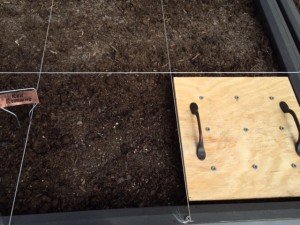
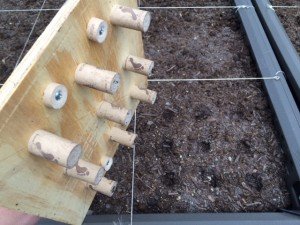 Lettuce can be planted 9 to a square foot so I pressed the spacer into 4 of my 1'x1' squares to leave divots where the seeds should be planted.Next I shook out some seed into my palm and placed 2 per divot. I normally have really good germination rates with the Baker Creek lettuce seeds, but these are last year's seeds so I did 2 to be safe. This was the most time intensive part of the whole operation but not what I would call laborious.
Lettuce can be planted 9 to a square foot so I pressed the spacer into 4 of my 1'x1' squares to leave divots where the seeds should be planted.Next I shook out some seed into my palm and placed 2 per divot. I normally have really good germination rates with the Baker Creek lettuce seeds, but these are last year's seeds so I did 2 to be safe. This was the most time intensive part of the whole operation but not what I would call laborious. When I was done I patted the soil over the seeds, lightly covering them and creating good dirt to seed contact then watered.
When I was done I patted the soil over the seeds, lightly covering them and creating good dirt to seed contact then watered.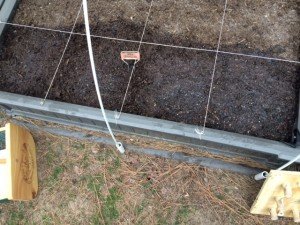 Voila!Yes there will be some watering throughout the season and yes, I do get an occasional volunteer plant that needs to be plucked out of my garden beds, but those are minor things, easily taken care of when I head out to my backyard grocery store each night and look around to see what's for dinner.
Voila!Yes there will be some watering throughout the season and yes, I do get an occasional volunteer plant that needs to be plucked out of my garden beds, but those are minor things, easily taken care of when I head out to my backyard grocery store each night and look around to see what's for dinner.
Springing Ahead
After a week of travel, timezone jet lag and leaping ahead an hour, I returned home to find my spring garden well underway.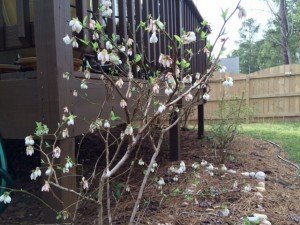 The blueberries and strawberries are already in bloom and hoping the 33 degree overnight currently forecast for Monday night doesn't damage them.
The blueberries and strawberries are already in bloom and hoping the 33 degree overnight currently forecast for Monday night doesn't damage them.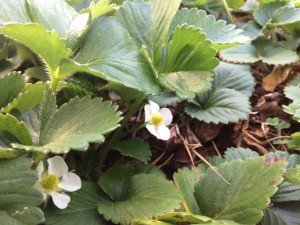 The collards, cabbage and kale have been hardened off and were transplanted yesterday near the sprouting spinach, pak choy, lettuce and sugar snap peas.
The collards, cabbage and kale have been hardened off and were transplanted yesterday near the sprouting spinach, pak choy, lettuce and sugar snap peas.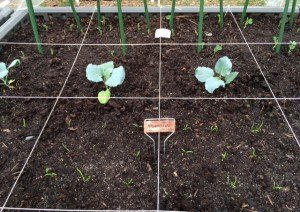 The 8 spears of asparagus that have been harvested so far have been well worth the 1 year wait and I hope some crowns that have not yet produced will begin to send up spears soon. In the meantime, I am becoming an expert on making a little asparagus go a long way in dishes.
The 8 spears of asparagus that have been harvested so far have been well worth the 1 year wait and I hope some crowns that have not yet produced will begin to send up spears soon. In the meantime, I am becoming an expert on making a little asparagus go a long way in dishes.
Batting 500
Getting Back On The Grid
With the spring starts happily growing indoors and awaiting the last frost date in April, today's sunny, spring-like* weather meant getting down to the business of putting the square back in square foot gardening.I have tried a few different materials to mark off my grids over the years with all surviving only a single year's exposure. This year I am trying a nylon string made for outdoor use and so I spent a good part of the day tying the string (and myself) into little knots.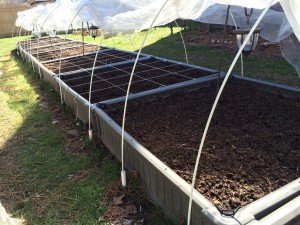 The square foot grids serve the useful purpose of being guides for plant spacing throughout the year when individual squares are turned over for different seasonal plantings, but they also serve as something of a study in contrast with their clean, angular lines soon to be mostly obscured by nature's riot of a summer garden.*A note on the continuing deception of Punxsutawney Phil - as I was preparing garden beds today I saw that the beautiful weather had tricked some of the Jersey Knight asparagus into putting up tender shoots despite two nights of freezing temps headed my way later in the week.
The square foot grids serve the useful purpose of being guides for plant spacing throughout the year when individual squares are turned over for different seasonal plantings, but they also serve as something of a study in contrast with their clean, angular lines soon to be mostly obscured by nature's riot of a summer garden.*A note on the continuing deception of Punxsutawney Phil - as I was preparing garden beds today I saw that the beautiful weather had tricked some of the Jersey Knight asparagus into putting up tender shoots despite two nights of freezing temps headed my way later in the week.
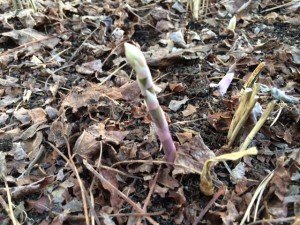 2015 was the first year in the ground for my 2 year old crowns so they were left in peace all year without a single spear being harvested. I am determined to get to sample a few spears this year and will be covering them with cloches on the coldest nights to protect the bounty that must be split between the crowns and me this year.
2015 was the first year in the ground for my 2 year old crowns so they were left in peace all year without a single spear being harvested. I am determined to get to sample a few spears this year and will be covering them with cloches on the coldest nights to protect the bounty that must be split between the crowns and me this year.
New Year's Resolutions (Then and Now)
For 2015 I set two gardening goals for myself - begin keeping a garden log and saving seed and I did pretty well on both of them. My 2015 garden log ended the year with 8 typed pages and containing details from pounds of tomatoes and serranos harvested to the date of the first and last blueberries. I used Word for Mac so I can keyword search in 2016 (and beyond) if I want to find when I planted the 3rd crop of edamame or when my squash and cucumbers were invaded by cucumber worms. I found I was more diligent about doing entries if I kept the document open on my second monitor at all times so when I began the 2016 garden log earlier this month detailing all the indoor starts for January, I continued with this practice.Prior to 2015, I had only saved my own cilantro/coriander seed and purchased everything else. At the end of 2015 I had saved 10 different varieties of everything from squash and chili peppers to flowers and tomatoes. My seed box, which has always been full of Baker Creek Heirloom Seeds packages is now peppered with the plain brown paper envelopes that I use for my own seed.For 2016 my two goals are saving even more of my own seed and mulching. Going from 1 to 10+ varieties that I saved seed from in 2015 is good, but I am growing over 53 annual varieties in 2016 so there is plenty of room to continue to improve in this goal.The Square Foot Gardening method I use places a heavy emphasis on compost but almost none on mulching. The SFG method recommends starting with a 33% compost mixture in the raised beds and continually adding compost as plants are removed and new plants added to each individual square foot, but no mention of covering the soil between and around plants. Soil science as well as observation have led me to understand that just as nature abhors a vacuum and will swiftly fill it, soil abhors being exposed and will cover itself with weeds if it must to protect it from the wind and the sun, allowing it to retain water better and reduce erosion.So for 2016 I will be experimenting with different types of mulches in my beds to see what works best, doesn't invite too many visiting pests and makes the plants and soil happy and healthy.Here's to getting better every year! #Kaizen
The Expat Starter Garden
A dear friend is moving south of the border to live on the shores of Lake Chapala, said to have the second best climate on earth, behind only Atenas, Costa Rica. She wants to start a small garden there and was looking for suggestions.All of these suggestions do very well in both containers (both patio and raised bed) and in rich garden soil, making them versatile, low maintenance choices for a first time gardener.If you are only going to grow one thing, I think basil is a great place to start. It is easy to grow, abundantly productive and can be added to almost every meal you make or have for takeout. I prefer the sweet genovese varieties.If you are only going to grow two things, then basil and cilantro are my choices. Again, easy, abundant and can add a bright taste to any dish, homemade or otherwise. For warmer climates (mine included) try a slo bolt variety.Oregano and rosemary are also low maintenance but useful and abundant herbs for a first time gardener and experienced cook.If she wants to expand beyond herbs, spinach is a great choice for novices. Leaves can be taken as needed allowing the plant to continue growing, many fresh or cooked uses and easy to grow. Again, with warmer climates, a slo bolt variety would be best.After spinach, the chili pepper of your preferred spiciness range. I favor serranos. They are very abundant producers, impart a great flavor in addition to the heat they add to dishes and can be picked green or red depending on your heat preferences. Roasting ripe ones each time you grill and freezing them means delicious roasted peppers on hand year round.And then every gardener's pride and joy, tomatoes. For many of the same reasons, I would recommend cherry type tomatoes for the small scale gardener. They produce much more abundantly than slicing tomato varieties and due to their size can be dried or roasted and frozen for year round additions to meals.With just these 7 items, incorporating bounty fresh from the garden (or preserved from the garden) year round is easy and will work into everyone's favorite dishes.
Countdown to Garden 2016
Even before presents are unwrapped, the countdown is on with less than a month to go before indoor starts of cabbage, leeks and rosemary get going in the first part of January with peppers (hot and bell) just behind.So I've been making my list and checking it twice this week to see what varieties will make it into my 219 square foot of garden space for 2016.I am making heavy use of containers for herbs (and one lettuce I just couldn't resist) and also using two composted trenches in the yard to grow The Three Sisters: corn, blackeyed peas and decorative squash. I currently have 8 1x1 boxes for cucurbits, but will be adding in 3 more before spring to hold all the zucchini, squash and cucumbers on my list.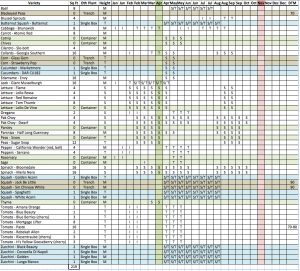 Despite planning 52 different varieties of annuals for next year, my 2016 seed order (including shipping) came in under $42. This economy was mostly due to saving more of my own seed this year than ever before and having plenty of unused 2015 seed for most of what I plan to grow next year - Square Foot Gardening makes better use of individual seeds than row gardening so more seeds are conserved for future use.
Despite planning 52 different varieties of annuals for next year, my 2016 seed order (including shipping) came in under $42. This economy was mostly due to saving more of my own seed this year than ever before and having plenty of unused 2015 seed for most of what I plan to grow next year - Square Foot Gardening makes better use of individual seeds than row gardening so more seeds are conserved for future use.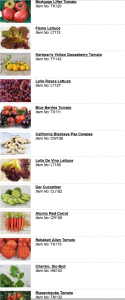 One of my splurge purchases for this year was the Slo-Bolt Cilantro. I am still drawing down the huge supply of cilantro/coriander seeds saved from my 2012 garden. They still have a high germination rate so I have been using them for both outdoor garden and microgreen plantings since then. If the slo-bolt lives up to its name, my 2012 cilantro has had its last reproductive cycle and will be only for microgreens and I will switch to saving the slo-bolt seed.Next I will start plotting out the placement of these plantings on my garden map. 2015 was my first full garden cycle in Raleigh and the biggest lesson was that maximizing light has to be a priority for north facing gardens further complicated by some tree shade. To that end, I added a height column with each plant ranked Short, Medium or Tall to plan my garden for next year. Tallest plants in to the north and shortest plants to the south has always been the rule of thumb but is now a requirement for my future garden plans which will make crop rotations a little more challenging.It is damp, but in the low-mid 70's this weekend, so I will also spend some time putting in new grids into my raised beds. I have been using kitchen string for the past few years but the cottony string only lasts one year before stretching, breaking and needing to be replaced. This year I am going to try a white nylon string that is made for outdoor use and hope it holds up better.Here's to a wonderful close to 2015 and a bright start to 2016! Happy Holidays!
One of my splurge purchases for this year was the Slo-Bolt Cilantro. I am still drawing down the huge supply of cilantro/coriander seeds saved from my 2012 garden. They still have a high germination rate so I have been using them for both outdoor garden and microgreen plantings since then. If the slo-bolt lives up to its name, my 2012 cilantro has had its last reproductive cycle and will be only for microgreens and I will switch to saving the slo-bolt seed.Next I will start plotting out the placement of these plantings on my garden map. 2015 was my first full garden cycle in Raleigh and the biggest lesson was that maximizing light has to be a priority for north facing gardens further complicated by some tree shade. To that end, I added a height column with each plant ranked Short, Medium or Tall to plan my garden for next year. Tallest plants in to the north and shortest plants to the south has always been the rule of thumb but is now a requirement for my future garden plans which will make crop rotations a little more challenging.It is damp, but in the low-mid 70's this weekend, so I will also spend some time putting in new grids into my raised beds. I have been using kitchen string for the past few years but the cottony string only lasts one year before stretching, breaking and needing to be replaced. This year I am going to try a white nylon string that is made for outdoor use and hope it holds up better.Here's to a wonderful close to 2015 and a bright start to 2016! Happy Holidays!
December Morning on the (Urban) Farm
 Some keep the Sabbath going to the ChurchI keep it, staying at HomeWith a Bobolink for a ChoristerAnd an Orchard, for a Dome
Some keep the Sabbath going to the ChurchI keep it, staying at HomeWith a Bobolink for a ChoristerAnd an Orchard, for a Dome
Some keep the Sabbath in SurpliceI just wear my WingsAnd instead of tolling the Bell, for Church,Our little Sexton sings.
God preaches, a noted ClergymanAnd the sermon is never long,So instead of getting to Heaven, at lastI’m going, all along. ~ Emily Dickinson
Mornings like this never fail to bring the words this poem that I loved since I was a young girl to mind. The beauty of the rising sun was rivaled by the sunset colors of the blueberry leaves all decked out in their fall colors. And the tender green leaves of the Tom Thumb lettuce growing in a container on my deck made the morning feel more like a late spring day than a warm winter one.
And the tender green leaves of the Tom Thumb lettuce growing in a container on my deck made the morning feel more like a late spring day than a warm winter one.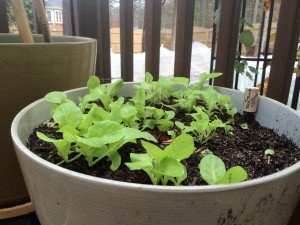 Now, if I just had that orchard dome...
Now, if I just had that orchard dome...
Store Bought Reboot - Regrowing Veggies
Here at NearlyHomeGrown, food scraps usually end up being frozen for future vegetable and/or chicken stocks or composted to feed the next generation of growing food. But I have been interested in the regrowing veggies craze and finally had the perfect reason to try it.The latest shiitake flush resulted in 7.7 oz of fresh mushrooms and they have been going into almost every meal in one way or another, but especially into homemade ramen noodle soup where they are a headliner ingredient. One of the other ingredients, the scallions, have been something of a philosophical splurge for this autumnal meal. They are store bought, out-of-season produce that I could live without but really didn't want to because of the flavor and color they add to the dish...and voila! The perfect vegetable to try regrowing!
One of the other ingredients, the scallions, have been something of a philosophical splurge for this autumnal meal. They are store bought, out-of-season produce that I could live without but really didn't want to because of the flavor and color they add to the dish...and voila! The perfect vegetable to try regrowing!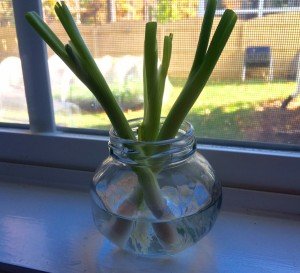 The green onion ends were pulled from the cooking scrap pile destined for stock making and put into a clear jar with fresh water and placed in a sunny window. The water will need to be changed every other day between now and spring when I will try planting them in my outdoor garden. In the meantime I can continue to steal the green tops for ramen soup and other dishes while keeping the root alive and growing.
The green onion ends were pulled from the cooking scrap pile destined for stock making and put into a clear jar with fresh water and placed in a sunny window. The water will need to be changed every other day between now and spring when I will try planting them in my outdoor garden. In the meantime I can continue to steal the green tops for ramen soup and other dishes while keeping the root alive and growing.
Quest For Fire
My tomatoes were troopers this year holding onto green romas, blue beauties and red delicious globes into early November, but I gave up and pulled the remainders two weeks ago just so I could begin cleaning the beds and preparing them for winter before heading off to a week's worth of meeting in San Diego last week.This weekend's task was to pull the rest of the serranos off before 3 consecutive nights of freezing or below temperatures hit them. My final harvest ended up being 1lb, 5oz of beautiful peppers that will warm dishes from now until next year. All were cleaned and vaccu-sealed before being frozen except for a few that will go into the Thanksgiving cornbread later this week.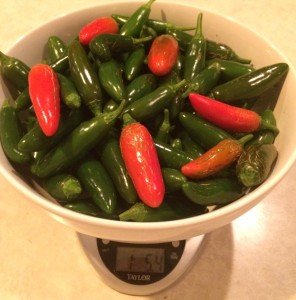 On another pepper note, a friend has some seeds that he will be sharing with me from his home country of El Salvador. I am keenly interested in growing them out next year since he doesn't know the name of them in either his native tongue or English. For now I am thinking of them as Mystery Pepper and what a fun mystery to solve!
On another pepper note, a friend has some seeds that he will be sharing with me from his home country of El Salvador. I am keenly interested in growing them out next year since he doesn't know the name of them in either his native tongue or English. For now I am thinking of them as Mystery Pepper and what a fun mystery to solve!
Variations On A Theme - Potato Leek Soup
My favorite recipes are the ones that resemble a good canvas - a delicious backdrop that can be accentuated and modified by what is in season and/or on hand. Having just finished a post about an overabundance of serrano peppers, I wanted to do a variation on a fall favorite - potato leek soup.This year's leeks are on the thin side which I attribute to my north facing backyard garden, so I harvested roughly 3x the number I would normally use for this recipe.
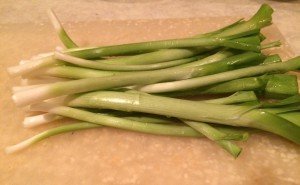 I decided to add some kick to the background canvas and finely chopped 4 roasted red serranos from my freezer and fresh oregano.
I decided to add some kick to the background canvas and finely chopped 4 roasted red serranos from my freezer and fresh oregano.
 On it's own, this soup is mild but hearty making it a perfect backdrop for any number of flavor profiles.
On it's own, this soup is mild but hearty making it a perfect backdrop for any number of flavor profiles. The genius of this soup is the mandolin sliced potatoes.
The genius of this soup is the mandolin sliced potatoes.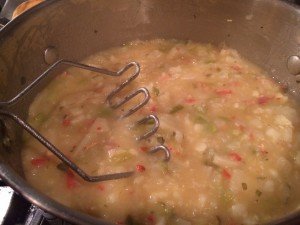 Once cooked through and gently mashed, they thicken the stock and the mashing breaks the potatoes into bite-sized pieces.
Once cooked through and gently mashed, they thicken the stock and the mashing breaks the potatoes into bite-sized pieces.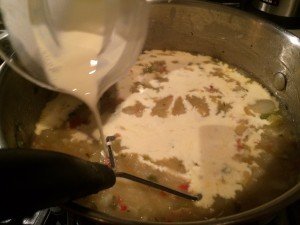 Add a little cream and cook on low for a few more minutes and voila!
Add a little cream and cook on low for a few more minutes and voila!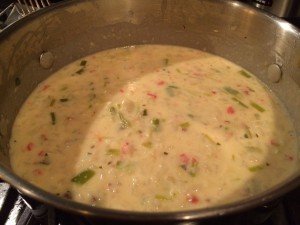 A delicious meal that varies depending on preferences and additions!
A delicious meal that varies depending on preferences and additions!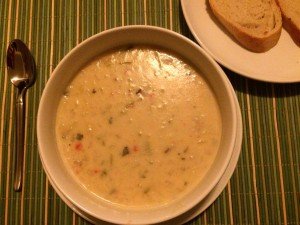
Cooking with Wilbur Scoville
My 3 serrano plants have produced so abundantly this year that even after freezing enough raw and roasted peppers to last until next year's harvest, giving away dozens more to friends and co-workers and drying many more to save seed, I am still drowning in the spicy, delicious peppers.I first learned the distinctive flavor and heat of these peppers back in 2010 after searching and trying one of those 'top secret restaurant recipes revealed' sites for the Chipotle guacamole recipe*. As soon as knife met serrano the unmistakable scent that I associated with Chipotle guac filled the air and I was sold on serranos and I have been growing them since.Serranos are a type of chili pepper that fits on the Scoville scale between between the less spicy jalapenos and the more spicy cayenne peppers. The Scoville chart has its shortcomings, but it is the closest thing to an authoritative ranking of spiciness of chiles that is in culinary use.What I like about serranos is that they have a taste, not just heat, so they add an actual flavor layer to dishes made with them, not just spiciness. I have not been able to find a chart on chili peppers and umami but my taste buds tell me serranos have it.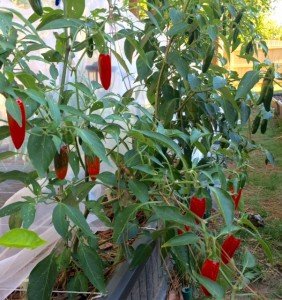 So as much as I love serranos, the still going bumper crop of this year's harvest has presented the challenge of what to do with all of these serranos!Drying ripe, red chiles to save seed made me wonder what the ubiquitous crushed red pepper flakes in my spice jars were made of. A bit of research later and I found that crushed (or dried) red pepper flakes are the result of red chiles, but can be made of a blend or different types and are usually not labeled with the type(s) of chiles inside and are generally blends of several types of peppers.Back in September I decided to gamble some of my over abundance on an experiment and dried about 10 fully red serranos and popped them into the food processor, seeds and all. The seeds are generally believed to convey even more heat to the dishes they are added to than the fruit body so most recipes specify that the seeds should be removed. But the crushed red pepper flakes I have seen always have visible seeds so I left them in.
So as much as I love serranos, the still going bumper crop of this year's harvest has presented the challenge of what to do with all of these serranos!Drying ripe, red chiles to save seed made me wonder what the ubiquitous crushed red pepper flakes in my spice jars were made of. A bit of research later and I found that crushed (or dried) red pepper flakes are the result of red chiles, but can be made of a blend or different types and are usually not labeled with the type(s) of chiles inside and are generally blends of several types of peppers.Back in September I decided to gamble some of my over abundance on an experiment and dried about 10 fully red serranos and popped them into the food processor, seeds and all. The seeds are generally believed to convey even more heat to the dishes they are added to than the fruit body so most recipes specify that the seeds should be removed. But the crushed red pepper flakes I have seen always have visible seeds so I left them in.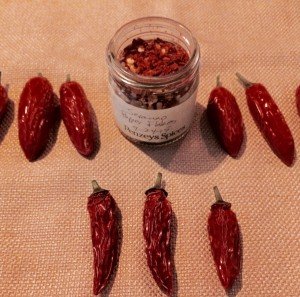 The experiment in making my own crushed red pepper flakes was a huge success! They definitely add the spicy kick that I am accustomed to with the store bought spice and my serrrano-only version is also adding the flavor and body that I associate with serranos.I am drying a second round of serranos to grind into spice mostly because I have to do something with them and I am beginning to think they might make spicy stocking stuffers :)*Interesting side note - the "official" recipe on the Chipotle website calls for jalapenos and is a possible red herring so that the made-at-home version does not taste quite as good as the restaurant version.
The experiment in making my own crushed red pepper flakes was a huge success! They definitely add the spicy kick that I am accustomed to with the store bought spice and my serrrano-only version is also adding the flavor and body that I associate with serranos.I am drying a second round of serranos to grind into spice mostly because I have to do something with them and I am beginning to think they might make spicy stocking stuffers :)*Interesting side note - the "official" recipe on the Chipotle website calls for jalapenos and is a possible red herring so that the made-at-home version does not taste quite as good as the restaurant version.
Fall Cleaning
Unlike houses that only gently admonish us once a year with the expression "Spring Cleaning", gardens ask that twice a year we get down and dirty and work until our backs and legs are singing to bring a temporary order before allowing nature to rule for another half-year.This weekend I have begun the Fall Cleaning in earnest. After a year of unmolested growth and rooting, it was time to cut back the asparagus and the strawberry runners and bed them down for the winter.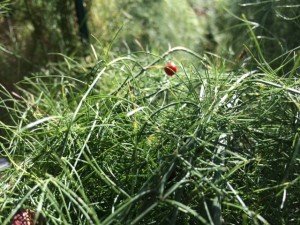 The 5' asparagus plants looked like little Christmas trees even before the seeds turned bright red two months ago and mimicked ornaments. In the past couple of weeks some of the green growth had started to yellow and then brown, signaling the time to remove the above ground part so the underground crowns could prepare themselves for winter.Asparagus has a long and storied history going back at least 5,000 years to Egyptian times and has the rare distinction of appearing in one of the oldest known recipe books De re coquinaria ("On the Subject of Cooking") from the 4th or early 5th century AD.
The 5' asparagus plants looked like little Christmas trees even before the seeds turned bright red two months ago and mimicked ornaments. In the past couple of weeks some of the green growth had started to yellow and then brown, signaling the time to remove the above ground part so the underground crowns could prepare themselves for winter.Asparagus has a long and storied history going back at least 5,000 years to Egyptian times and has the rare distinction of appearing in one of the oldest known recipe books De re coquinaria ("On the Subject of Cooking") from the 4th or early 5th century AD.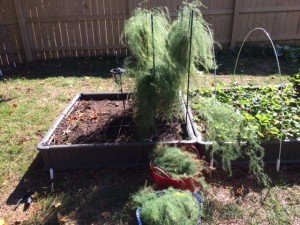 My Jersey Knight and Purple Passion asparagus crowns were transplanted into my garden in the earliest part of 2015 meaning that I could not harvest anything this first year and could only watch as the tender shoots grew to and then beyond edibility stage and finally into the fern like growth above.Although I could not eat the shoots this year, nothing goes to waste in my garden and the green growth that had fed and nurtured the crowns all year were cut into 2-3" sections to be composted and feed future growth.
My Jersey Knight and Purple Passion asparagus crowns were transplanted into my garden in the earliest part of 2015 meaning that I could not harvest anything this first year and could only watch as the tender shoots grew to and then beyond edibility stage and finally into the fern like growth above.Although I could not eat the shoots this year, nothing goes to waste in my garden and the green growth that had fed and nurtured the crowns all year were cut into 2-3" sections to be composted and feed future growth. Once the asparagus and strawberry beds were cleaned up they were fitted with low hoops and covered with water and light permeable mesh that will hopefully keep the squirrels and pine needles out until spring.I have been looking into organic mulching options and ran across Leaf & Limb Tree Service's site that offered free wood chips delivered to your home (with some caveats). An inquiry has been sent and hopefully soon I will have my crowns bedded down for winter and am already looking forward to getting to harvest some of my own asparagus shoots next year!
Once the asparagus and strawberry beds were cleaned up they were fitted with low hoops and covered with water and light permeable mesh that will hopefully keep the squirrels and pine needles out until spring.I have been looking into organic mulching options and ran across Leaf & Limb Tree Service's site that offered free wood chips delivered to your home (with some caveats). An inquiry has been sent and hopefully soon I will have my crowns bedded down for winter and am already looking forward to getting to harvest some of my own asparagus shoots next year!


